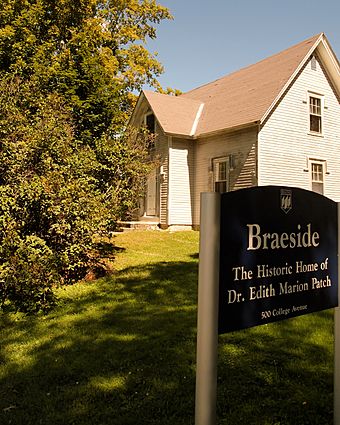Edith Marion Patch House facts for kids
Quick facts for kids |
|
|
Edith Marion Patch House
|
|
 |
|
| Nearest city | Old Town, Maine |
|---|---|
| Area | 2.3 acres (0.93 ha) |
| Architectural style | Gothic Revival |
| NRHP reference No. | 01001269 |
| Added to NRHP | November 29, 2001 |
The Edith Marion Patch House is a special old house in Old Town, Maine. It was built around 1837. From 1913 to 1954, it was the home of Edith Marion Patch. She was a famous entomologist, which means she studied insects. She was also a writer. Edith named her home Braeside because of the pretty Scottish bluebell flowers that grew there.
This house was almost torn down in 2000. Luckily, it was saved! Now, there are plans to turn it into a research center and museum. This new center will teach people about Edith Patch's life and her important work. The house was added to the National Register of Historic Places in 2001. This means it is a very important historical building.
About the House and Edith Patch
The Patch House is located near the University of Maine campus. It is a one-and-a-half-story house made of wood. It has a classic "Cape style" design with a sloped roof. There's also a two-story part added to the back of the house. The front of the house looks balanced, with a main door in the middle and windows on each side.
The house was built a long time ago, around 1837. It was made bigger twice, with the last changes happening around 1900. Edith Marion Patch bought the house in 1913. At that time, it came with a huge piece of land, over 90 acres! She later sold some of the land. Edith lived in this house with her sister, Alice. Edith passed away in 1954, a few years after Alice.
Edith Patch's Amazing Work
Edith Patch was a very smart scientist. She went to the University of Minnesota. The University of Maine hired her to work at their agricultural experimental station. This is a place where scientists study farming and plants. Edith eventually became the head of that station! She spent her whole career working there.
Edith wrote many articles for important science magazines. She did amazing research on tiny insects called aphids. Aphids are small bugs that can cause big problems for crops. Edith's work helped farmers understand and deal with these pests. She retired from the university in 1937 but kept working on her projects.
Saving a Historic Home
In 1997, the University of Maine owned the house. They planned to let the Old Town Fire Department use it for a training exercise, which meant burning it down. But then, the Maine Historic Preservation Commission stepped in. They realized the house was very important and could be listed on the National Register of Historic Places.
The house was even listed as one of Maine's 10 most endangered historic properties. Because of this, the University of Maine worked with different groups. They raised money to save the house and fix it up. Thanks to their efforts, the Edith Marion Patch House was preserved for future generations.



